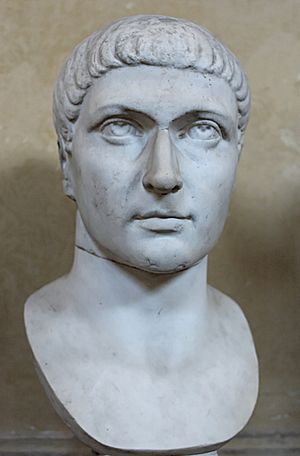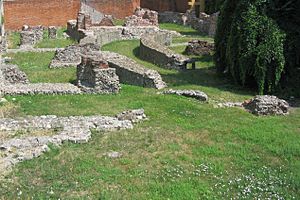Edict of Milan facts for kids
The Edict of Milan was an important agreement made in February 313 AD. It allowed Christians to practice their religion freely within the Roman Empire. Two powerful leaders, Western Roman Emperor Constantine I and Emperor Licinius (who ruled the Balkans), met in Mediolanum (which is modern-day Milan). There, they decided to change how Christians were treated. This agreement built on an earlier rule of tolerance issued by Emperor Galerius two years before. The Edict of Milan made Christianity a legal religion and stopped the harsh treatment of Christians. However, it did not make Christianity the official religion of the Roman Empire. That happened later, in 380 AD, with the Edict of Thessalonica.
We know about the Edict of Milan from writings by two ancient historians: Lactantius in his book De mortibus persecutorum and Eusebius of Caesarea in his History of the Church. The version from Lactantius is actually a letter from Licinius to governors in the Eastern Empire. It was sent from Nicomedia after Licinius won a battle against another ruler, Maximinus.

Contents
Why Was the Edict of Milan Needed?
The Romans were very religious people. They believed their success as a powerful empire came from having good relationships with their many gods. They honored a large number of gods and goddesses. The Romans also adopted some religious practices and myths from the Greeks. Their ancient religion was a big part of their identity and traditions. They often found ways for the religions of other peoples in their empire to fit in with their own beliefs.
Why Were Christians Treated Differently?
Christians and Jewish people believed in only one God. This belief was different from the Roman system, which accepted many gods. Christians also refused to swear loyalty oaths to the emperor's divinity, meaning they wouldn't worship the emperor as a god. This was seen as a threat to the state. Because of this, Christians faced many forms of persecution.
Emperor Decius (who ruled from 249–251 AD) made strict rules against Christians. His successor, Valerian, continued this policy. But then, Emperor Gallienus (who ruled from 253–268 AD) brought a period of nearly 40 years without official punishments for Christians. This time was called the "little peace of the Church". However, persecutions started again until 311 AD, when Emperor Galerius issued an edict from Nicomedia that officially ended them.
What Was Galerius's Edict of Toleration?
Since 235 AD, different Roman emperors had either supported or persecuted Christians to gain power. The Edict of Toleration by Galerius was issued by Emperor Galerius from Serdica and put up in Nicomedia on April 30, 311 AD. This edict granted Christians "indulgence," meaning they were allowed to practice their faith.
The edict stated:
Wherefore, for this our indulgence, they ought to pray to their God for our safety, for that of the republic, and for their own, that the commonwealth may continue uninjured on every side, and that they may be able to live securely in their homes.
This meant that Christians should pray to their God for the safety of the emperors and the empire, so that everyone could live peacefully.
What Did the Edict of Milan Say?
The actual letters of the Edict of Milan have not been found. However, they are quoted in detail by Lactantius and Eusebius. Lactantius's book includes the Latin text of Galerius's edict from 311 AD and Licinius's letter of tolerance and property return, which was sent to the governor of Bithynia on June 13, 313 AD.
This letter from Licinius stated:
When we, Constantine Augustus and Licinius Augustus, met so happily at Milan, and considered together all that concerned the interest and security of the State, we decided ... to grant to Christians and to everybody the free power to follow the religion of their choice, in order that all that is divine in the heavens may be favorable and propitious towards all who are placed under our authority.
This part shows that Constantine and Licinius agreed to allow everyone, including Christians, to choose their own religion. They hoped this would bring favor from the gods and keep the empire safe.
Eusebius of Caesarea translated these documents into Greek in his History of the Church. His version of Licinius's letter likely came from a copy posted in the province of Palaestina Prima in 313 AD.
Who Was Maximinus Daza?
The Edict of Milan was also aimed at Maximinus Daza, who was a ruler in the East. Even though Emperor Galerius had told him to stop persecuting Christians in 311 AD, Maximinus had not released Christians from prisons or mines. After Galerius died, Maximinus started persecuting Christians again in his territories. He even encouraged people to send petitions (formal requests) against Christians. One such petition, found carved in stone, asked that Christians "should at last be put down and not be suffered by any absurd novelty to offend against the honour due to the gods."
Did the Edict Only Help Christians?
Many people think the Edict of Milan was only about Christianity, or that it made Christianity the official religion. But this is not true. The Edict clearly gave religious freedom not just to Christians, but to all religions. The official religion of the Empire did not become Christianity until the Edict of Thessalonica in 380 AD.
The edict stated:
When you see that this has been granted to [Christians] by us, your Worship will know that we have also conceded to other religions the right of open and free observance of their worship for the sake of the peace of our times, that each one may have the free opportunity to worship as he pleases; this regulation is made that we may not seem to detract from any dignity of any religion.
—"Edict of Milan", Lactantius, On the Deaths of the Persecutors (De Mortibus Persecutorum), ch. 48. opera, ed. 0. F. Fritzsche, II, p 288 sq. (Bibl Patr. Ecc. Lat. XI).
This shows that the rulers wanted peace and allowed everyone to worship as they pleased, without disrespecting any religion. Licinius, who wrote the edict, was a pagan (someone who believed in many gods), while Constantine was already a Christian. Constantine's own policy went beyond just tolerating Christianity; he actively supported it while still allowing other religions.
Was Constantine a Christian?
The Edict of Milan is often seen as Constantine's first major act as a Christian emperor. Some historians debate if it was a true act of faith or a smart political move. They suggest Constantine might have seen the Christian God as a powerful deity and wanted to make an alliance to keep the empire stable. However, most historians believe that Constantine truly converted to Christianity. They see the Edict of Milan as his first official step as a dedicated Christian, especially since he continued to favor Christianity throughout his reign.
The Peace of the Church
Galerius's earlier edict did not return property that had been taken from Christians. The Edict of Milan changed this. It ordered that meeting places and other properties belonging to Christians be returned. The state would even pay compensation to the current owners of these properties.
The edict said:
the same shall be restored to the Christians without payment or any claim of recompense and without any kind of fraud or deception.
This meant Christians would get their property back for free. The provincial leaders were told to carry out this order quickly to restore public order. The goal was to ensure divine favor would "preserve and prosper our successes together with the good of the state." Constantine even ordered that the state should pay for the restitution.
For Christians, these new rules were very important. For the first time, they could openly practice their religion and try to shape the empire's life according to Christian values. Eusebius expressed the great joy of Christians about this change in his "Church History." This period in Church history is also known as the "Peace of the Church". Eusebius wrote that the edict stated: "it has pleased us to remove all conditions whatsoever."
The edict also demanded that individual Romans correct any wrongs they had done to Christians. This was not just about fairness for Christians; it was also to ensure "public order may be secured." The leaders hoped that by correcting past wrongs, they could avoid social unrest and further problems for the state. Some believe Constantine was superstitious and thought that restoring justice with Christians would help bring stability back to the empire.
The term "Peace of the Church" is also used in other historical contexts, such as in England and Ireland when persecution ended after the Acts of Catholic Emancipation (1778–1926). In Germany, it refers to life after the Kulturkampf.
See also
 In Spanish: Edicto de Milán para niños
In Spanish: Edicto de Milán para niños


